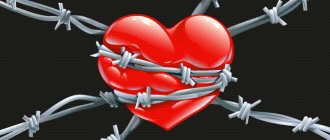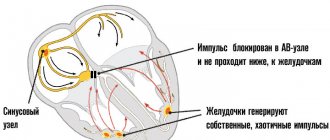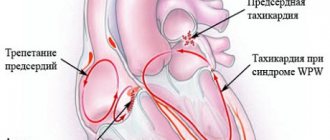Features of resuscitation
Resuscitation must be started in adults and children, without waiting for the arrival of ambulance specialists, when symptoms appear: lack of pulse in the carotid arteries, lack of breathing, the skin acquires a gray-bluish tint, the pupils are dilated and do not respond to light.
- Place the patient on the floor or other hard, flat surface.
- Tear or cut outer clothing to provide access to the chest.
- Tilt the patient's head back as far as possible, place one hand on the forehead, and with the other push the patient's lower jaw forward. This technique ensures airway patency.
- Make sure there are no foreign bodies in the mouth and throat, and if necessary, remove mucus with a quick movement.
Compliance with the rules of resuscitation is a step towards its successful completion.
Breathing “mouth to mouth”. A napkin, a piece of gauze or a handkerchief is placed on the patient’s lips. A deep breath is taken, the lips are pressed tightly to the patient’s mouth. Then they exhale forcefully (for 2-3 seconds), while closing the person’s nose. The effectiveness of artificial ventilation can be seen by raising the chest. The frequency of breaths is 16-18 times per minute.
Indirect cardiac massage. Place both hands on the lower third of the sternum (approximately in the center of the chest), standing on the left side of the person. Energetic pushes are performed towards the spine, shifting the surface of the chest by 3-5 cm in adults, 1.5-2 cm in children. The frequency of pressing is 50-60 times per minute.
When combining mouth-to-mouth breathing and cardiac massage, as well as carrying out activities by one person, it is necessary to alternate 1 breath with 4-5 chest compressions. Resuscitation is carried out until emergency personnel arrive or until the person shows signs of life.
If the patient has regained consciousness, do not leave him alone under any circumstances.
Forecast
The prognosis for a comatose state depends on the cause, as well as the degree of depression of consciousness and the duration of its depression. In case of precoma or the presence of stage I coma, a favorable prognosis is noted. In the case of coma II and III degrees, the prognosis is questionable, but there is hope for recovery. If we consider a IV degree coma, it most often ends in death. A deep coma lasting more than 24 hours has a poor outcome. If reflexes are absent for less than 6 hours, the prognosis is relatively favorable.
Favorable prognostic factors are:
- Early return of speech.
- Spontaneous eye movements.
- Preserved muscle tone at rest.
- Ability to execute commands.
The prognosis is unfavorable if patients, after circulatory arrest, experience:
- Myoclonic status epilepticus .
- Lack of pupil reaction for 24-72 hours.
- Absence of corneal reflexes.
- No response to pain within 72 hours.
In uremic coma, all reflexes and motor reactions may be lost, but recovery after treatment is complete. If hypothyroid coma , death occurs in 60-90%.
If a patient develops a hepatic coma against the background of chronic liver pathology, then every fifth person does not come out of it and death occurs after 1-3 days. How long do people live in a hepatic coma after they come out of it? This period depends on many factors, but most often the life span does not exceed several months, provided that the patient is constantly supported by liver function. Life extension is possible through organ transplantation - patients live from 5 to 10 years. Coma with fulminant hepatitis ends in death in 85% of patients. Patients with liver failure live for 3 months.
Hypoglycemic coma
Hypoglycemia is clinically manifested when blood glucose decreases to 2.8 mmol/l or more.
Basic diagnostic signs: rapid development of coma, pronounced moisture of the skin, muscle hypertonicity, clonic-tonic convulsions.
- with any change in behavior in a patient with diabetes (unmotivated or inappropriate actions, confusion), hypoglycemia should be suspected;
- after relief of hypoglycemic coma, ECG monitoring (to exclude MI) and a careful neurological examination (to exclude stroke) are required;
- In any case of hypoglycemia, poisoning with insulin or oral antidiabetic drugs must be excluded.
Medical care for hypoglycemic coma
- Ensure reliable venous access.
- Thiamine chloride (vit. B1) 5% 2 ml intravenously (the administration of thiamine is especially important in patients who abuse alcohol).
- Glucose 40% 60 ml IV (the rate of administration should not exceed 10 ml/min).
- If the patient’s consciousness is not restored within 5-10 minutes and/or the blood glucose level remains below 5.5 mmol/l, re-introduce 40-60 ml of 40% glucose solution intravenously (total dose of 40% glucose solution is not more than 120 ml !).
- Failure to restore consciousness in the patient, despite normalization of blood glucose levels, may indicate the development of cerebral coma (due to cerebral edema due to prolonged hypoglycemia):
- restoration of patency of the upper respiratory tract, evacuation of mucus and/or vomit from the oral cavity, oxygen therapy (oxygen 40-60 vol%);
- mannitol 20% 200 ml IV for 10 minutes, magnesium sulfate 25% 10 ml, dexamethasone 8 mg (0.4% 2 ml) IV.
In case of oral poisoning with hypoglycemic drugs - gastric lavage followed by the administration of enterosorbent (activated carbon or polyphepan) at the rate of 1 g per 1 kg of the patient's weight, and when seeking medical help 6-8 hours after poisoning, also a saline laxative (magnesium sulfate 25 % 50 ml).
After regaining clear consciousness and glycemic levels, leave the patient at home and transfer the asset to a health care facility.
Indications for hospitalization:
- Pathogenesis, clinical picture and care for hypoglycemic and hyperglycemic coma
- if the patient lives alone;
- recurrence of hypoglycemic coma during the day;
- poisoning with glucose-lowering drugs;
- development of cerebral coma (lack of recovery of consciousness in the patient, despite normalization of blood glucose levels).
In case of refusal, the asset is in the health care facility.
Causes
The reasons for this condition are varied and the following can be distinguished:
- Traumatic factors (brain injury, exposure to electric current).
- Thermal effects (this can be overheating and hypothermia).
- Exposure to neurotoxins ( ethylene glycol , alcohol substitutes , drugs in toxic doses, barbiturates and sedatives ).
- Hypoxia.
- Infectious factors (exposure to neurotropic viruses, toxins of botulism, malaria, typhus).
- Exposure to large doses of radiation.
- Pathological conditions ( stroke , brain tumor , cerebral edema , abscess ).
- Blood pathology ( hemolysis of red blood cells , anemia ).
- Respiratory failure.
- Liver failure.
- Kidney failure.
Hyperglycemic coma is provoked by:
- Incorrect administration of insulin (reducing the dose and number of injections, unauthorized withdrawal of insulin).
- Infections.
- Injuries and surgeries.
- Acute cardiovascular diseases.
- Psycho-emotional stress.
- Taking drugs.
- Long-term use of glucocorticoids and diuretics.
- Pregnancy.
Hypoglycemic coma is provoked by:
- Violation of the diet with skipping meals.
- Insulin overdose (faulty syringe pen, error in dose calculation, malfunction of the glucometer).
- Drinking alcohol.
- Changing insulin medications.
- Excessive loads.
- Impaired kidney and liver function.
Hyperglycemic coma: emergency care algorithm before the doctor arrives
With this kind of problem, it is extremely important to immediately provide first aid to the patient. So, for diabetic coma, the emergency care algorithm assumes the following:
- The person is placed on a flat surface in a horizontal position.
- The patient is provided with a free flow of fresh air. To do this, remove outer clothing, remove belt, tie, etc.
- The head is turned to the side. Otherwise, the victim may choke on gastric secretions in the event of an attack of vomiting.
- Determine whether the patient is taking insulin injections. If confirmed, conditions are created for introducing the required dosage of the drug into the blood.
- If possible, record the pressure level in order to communicate the obtained data to ambulance workers.
- Before the doctor arrives, the person is given warm, sweet tea.
- If breathing stops or the pulse disappears, the victim is given artificial respiration or chest compressions.
Prevention
If there is an endocrinological pathology, in this case diabetes mellitus, the patient needs to carefully monitor his condition and its changes. People suffering from diabetes are usually well aware of changes in their condition, regularly measure their sugar levels at home and immediately take action. Patients know that after an insulin they need to eat, they keep a diabetic diary and follow a diet. Persons who are not treated or do not know about the presence of diabetes mellitus can bring themselves into a coma. Severe stress, alcohol exposure, or severe infectious diseases can provoke a sharp deterioration in their condition, even to the point of coma.
Pathogenesis
This condition is caused by a deficiency of insulin in the blood against the background of an increase in glucose concentration. The complication is life-threatening.
The pathogenesis of hyperglycemic coma is explained by impaired metabolic processes in the diabetic body. With insufficient synthesis of insulin, a protein hormone necessary for the utilization of glucose, metabolism is disrupted. Glucose does not penetrate the body's cells, but remains in the blood. Over time, high glucose concentrations occur. This condition is called hyperglycemia. Ketone bodies are formed, gluconeogenesis is activated in the liver, acidosis occurs, and intoxication of the central nervous system occurs. This leads to diabetic coma.
Rarely, hyperglycemic coma occurs before diabetes is diagnosed.
There is a classification that allows you to determine the type of complication depending on the etiology and mechanism of development.
In 80% of diagnosed cases, ketoacidotic coma is diagnosed. Most often it develops in patients with type 1 diabetes. Usually occurs in young people under 20 years of age. According to statistics, 1 out of 3 patients suffering from the juvenile form of the disease experienced a similar condition. This form can transform into hyperosmolar and vice versa.
Hyperglycemic coma without ketosis is also distinguished. This condition is accompanied by an increase in blood glucose levels, while the body does not begin to break down fat tissue for energy. As a result, ketone bodies are not released, as in ketoacidotic coma.
On average, 4–31% of deaths are recorded. Death often occurs in the elderly and patients with weakened bodies.
- Emergency care and symptoms of hypoglycemic coma
Diet
Diet 9th table
- Efficacy: therapeutic effect after 14 days
- Timing: constantly
- Cost of products: 1400 - 1500 rubles per week
Diet for low blood sugar
- Efficacy: stabilization of blood sugar levels
- Dates: no data
- Cost of food: 1930 - 2100 rubles per week
In each specific case, for various diseases, dietary nutrition is indicated. For diabetes mellitus - Table No. 9 , for kidney pathology Table No. 7 , and for liver diseases - Table No. 5 . In hepatic encephalopathy, correction of nitrogen metabolism is crucial. 75% of patients with hepatic encephalopathy have protein and energy deficiency, which is accompanied by loss of muscle and energy reserves. Long-term restriction of protein in the diet is harmful for such patients, since the need for it in this condition is lower than in healthy people. Weight loss and muscle breakdown increase hepatic encephalopathy, so it is necessary to provide the body with sufficient protein and energy and achieve a positive nitrogen balance. In this regard, for normal weight, a daily protein intake of 1.2-1.5 g/kg is recommended, and the calorie content of the diet should be maintained at 2400 kcal.
It is recommended to eat evenly throughout the day and have a snack before bed. You need to limit your protein intake during the first days of the onset of encephalopathy, and then return to your normal protein intake. To reduce the amount of protein, it is replaced with vegetable or dairy or a complex of branched chain amino acids - BCAA in capsules.
List of sources
- Efimov A. S., Komissarenko I. V., Skrobonskaya N.A. Emergency endocrinology. – M.: Medicine, 1982, – 208 p.
- Balabolkin M.I., Lukyanchikov V.S. Clinic and therapy of critical conditions in endocrinology. – Kyiv: Health, 1982, – 152 p.
- Kurek, V.V. Guide to emergency conditions in children / V.V. Kurek, A.E. Kulagin. 2nd ed. Moscow: Med. lit., 2012, - 464 p.
- Sumin, S. A. Anesthesiology, resuscitation, intensive care: textbook. for students of institutions of higher professional education / S. A. Sumin, I. I. Dolgina. Moscow: Medical Information Agency, 2015, 496 p.
- Krylov, V.V. Neuroreanimatology. Practical guide / V. V. Krylov, S. S. Petrikov. Moscow: GEOTAR-Media, 2010, - 176 p.










